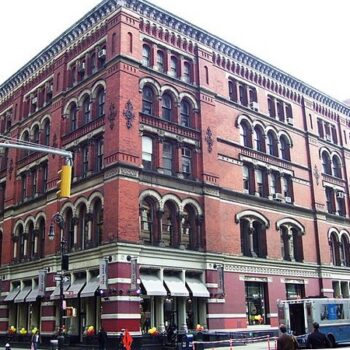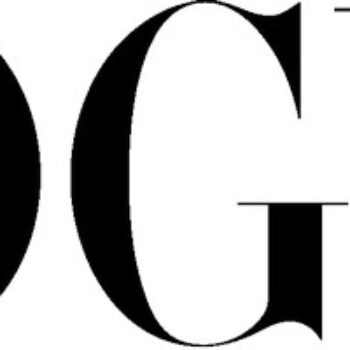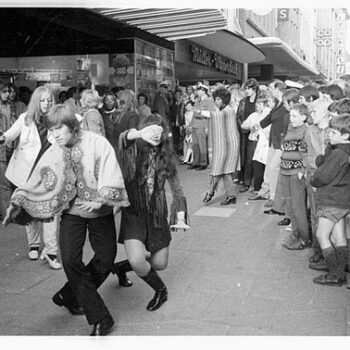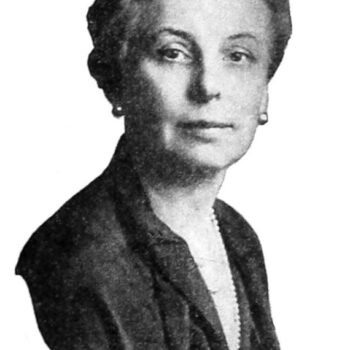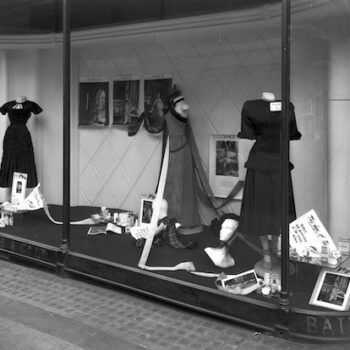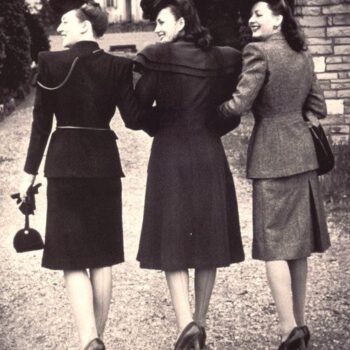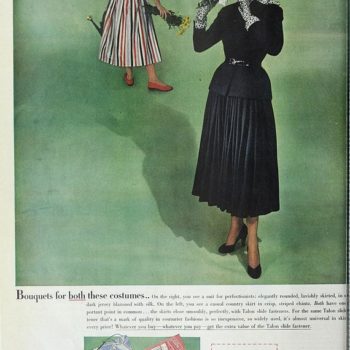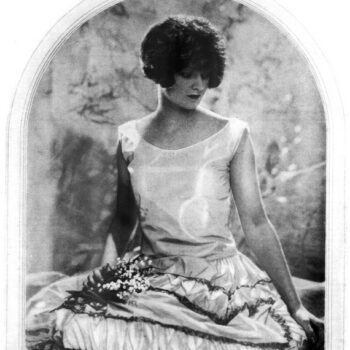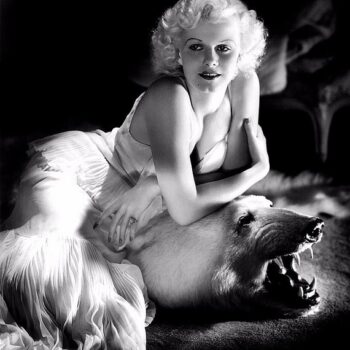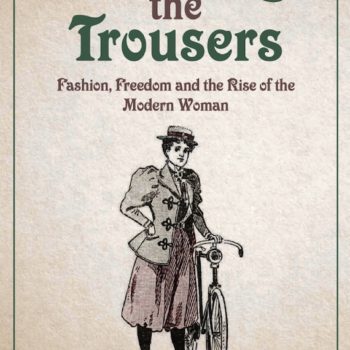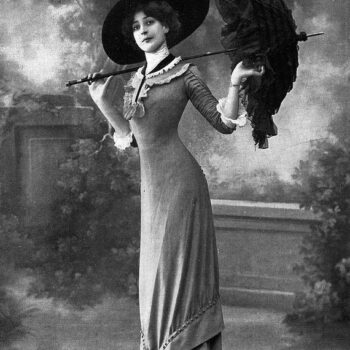Womens fashion 1916
May 22, 2016As the war progressed, imports became harder to arrange, and luxuries like fashion magazines were the first to go. Women who had relied on the American title, Vogue, for all their fashion news, were bereft and there was an obvious gap in the market. Conde Nast, Vogue’s publisher, stepped into the breech and launched a British edition. Despite it being wartime, womens fashion 1916 went on, and Vogue was there to celebrate them.
“‘The time has come,’ designers say, ‘to talk of many things, – of shoes and furs and lingerie, and if one flares or clings, and where the waist-line ought to be, and whether hats have wings.’ Thus ran the delightful introduction of the first ever British Vogue, hitting the stands in September 1916.
1916 – the launch of British Vogue
Instead of many cover stories, this first issue has only one: “This Number a Forecast of Autumn Fashions”. The introduction goes on to promise “It is crammed to its advertisements with the authentic reports of the winter modes. In it the Paris couturiers have the first of their heart-to-heart talks about the winter. Nervous people do well to avoid this number; it is full of thrilling surprises in costumes and hair-raising adventures in millinery, and its short stories about lingerie are apt to just be the least bit risqué.”
Womens fashion 1916 – playful magazines
I love the language of these early Vogues. The articles are playfully written and the tone usually light hearted yet with a seriousness about the intricacies of the costumes they describe. As much as a whole page can be spent on describing the details of just one woman’s outfit, spotted while walking the chic boulevards of Paris.
Because at this point, although the text promises a heart to heart with notable couturiers about womens fashion 1916 it wasn’t all about the catwalk shows or what a designer deemed autumn fashion to be, but very much about street style and what the rich, beautiful and famous women were wearing at a fashionable London house party or for a shooting weekend in the country, on stage or strolling along the boulevards of Paris or the paths of Hyde Park. British women also had a bit of a cafe society going on by now and took pleasure in shopping, so also displayed their fashion sense gathering to take tea in Selfridges.
Womens fashion 1916 – the rich and the beautiful
At this date the rich, beautiful and famous didn’t consist of movie stars as it mostly does today, although there were one or two silent film stars of whom Charlie Chaplin was probably the most famous. Nor was the focus on pop stars, because they didn’t really have them, either, because record players for the home weren’t common and it was the music itself , in the form of sheet music, that was bought, albeit in the form of songs made popular in music hall or stage performances. Some stars of the stage were adored, like Lily Elsie, who initiated a craze for massive hats back in 1907 when she starred in a play called the Merry Widow wearing one.
But most of the fashion focus was on socialites and what they were wearing. Debutantes were often featured in their finery, sometimes on the front cover or the first page. Other interesting socialites were also photographed by leading society portraitists, including E.O.Hoppen and Cecil Beaton. Because Vogue was originally an American publication British readers were quite used to reading all about the American rich, and in fact the American “princesses” shopped at exactly the same places as European Royalty, i.e. mostly Paris. But luckily US readers were just as enamoured of reading about what their British counterparts were up to, and titled English women were featured too.
The first few British issues therefore barely deviated from the editions that their American cousins received but for a few edits to anglicise spelling.
Womens fashion 1916 – gossip and gardening
Josephine Redding, the first American editor of Vogue, (which had been established in 1892) was quite amusingly anti fashion, proclaiming that “Humps. Women today are all covered with humps,” she wrote. “Big humpy sleeves, humps on their hips, humps on their behinds, it’s nonsense.” Vogue was conceived as a society journal for both genders and as well as this main topic wrote about gardening, beauty, animals, etiquette, sports, hobbies and anything else the writers cared to contribute, including long rambling rants. Despite the editor’s aversion to fashion, however, Vogue’s main income was actually made to order paper patterns, so its fashion plates were quite important.
Womens fashion 1916 – Vogue the technical advisor
Vogue was not, it should be noted, an aspirational magazine, full of couture that most of its readership can only daydream about and glamorous stars that they will never in their lifetime meet, but a journal aimed at the class of people it depicted – the fashion advice was in earnest and the gossip about people they probably knew. By 1909 American Vogue had been bought by the publisher Condé Nast, and he was able to announce it “the technical advisor—the clothing specialist—to the woman of fashion in the matter of her clothes and personal adornment.”
Womens fashion 1916 – the bi-monthly British Vogue
Which brings us to 1916 and the launch of British Vogue, which was published twice a month and continued in the mould of its American sister. Condé Nast was appalled when Dorothy Todd took over the editorship from original editor Elspeth Champcommunal in 1922, and tried to give the British version its own identity with short stories and avant-garde poetry. Incidentally Todd was a friend of Virginia Woolfe, and both featured her in photographic portraits and commissioned her for essays, which are thoughtful, charming, extremely long and not about fashion at all.
Nast thought fiction would give Vogue too much of a mainstream appeal, and he wanted to keep it exclusive at least in part because the advertisers knew that the current readers could afford their expensive goods. She was sacked in 1926 and it was when Alison Settle took over in 1926 that British Vogue really came into its own and gained its reputation as a peerless fashion source.
Womens fashion 1916 – war in Vogue
But to go back to 1916. Vogue did not, as has been said, turn a blind eye to the fact of war, it’s just that it took a determinedly light hearted attitude to it. There is nothing more escapist than thinking about wisps of silk and gorgeous perfumes, whether you’re a woman worrying about a man in the trenches or, apparently, a man experiencing those trenches. Vogue was a much requested magazine for soldiers away from home.
I love the caption under this image from American Vogue in August 1916 (third from left): “All the bravery is not in the trenches. “Paris still holds this dauntless young person who, with heroic boredom, faces the camera.” This exemplifies the light and often sardonic fashion commentary of the publication, as well as demonstrating the acknowledgement of the war. The other captions, in order from left to right say “In Paris, it rains whenever it can’t think of anything else to do. However, there are occasional bright moments like this one”. “A straight and narrow background for a collar and a row of buttons – is improbable, but such simple things do happen, even in Paris”. “It was the hottest day of summer; therefore, the only thing for a true Parisienne to do was to don her summer furs and look cool”.
Photos, illustrations and fashion plates
Photographs, like this, had first been introduced into American Vogue in 1913: before that black and white sketches and special hand coloured plates were the norm. Now they used a mixture of exquisite sketches and rather more down to earth photos – there were few professional models then and although some of the socialites posed beautifully, those snapped on the streets didn’t automatically have an alluring pout practiced and ready.
Womens fashion 1916 – Vogue’s art deco covers
It would be a long time before photos replaced the beautiful full cover illustrations of the cover. These were made by famous artists of the day such as George Lepape and often featured fantasy elements like elegant ladies on white peacocks or sportily striped women slaying polar bears, the pooling blood nicely matching their leg warmers. Here are some from 1917, 1918 and 1919 too, because I couldn’t stop at one or two from just 1916.
Womens fashion 1916 – in Vogue’s opinion
And what does Vogue announce as the fashions for 1916? In September: ”Some autumn frocks are moyen âge, and some are directoire, and some are neither; but all agree that as days are growing shorter, skirts are growing longer.” By early December it’s all about green: “The time, the place, or the fabric makes no difference; the Parisienne’s day is not complete unless she wears the colour of spring.”
The Queen of Spain and fur petticoats
The late December issue rhapsodises over the Queen of Spain and her interpretation of womens fashion 1916: “Since the war has spread itself over Europe, Queen Victoria and King Alfonso have been forced to discontinue their frequent journeys on the Continent and to stay in their own sunny country. The Queen of Spain, who was Princess Ena before her marriage, is famed for her faultless taste in dress, as well as for her magnificent jewels. Like her husband, she is extremely popular with her subjects.” And what should the fashionistas be wearing?
“Heavily disguised in fur, the tunic creeps back into fashion, and beneath it peeps a fur petticoat – monkey fur has caught the Parisienne’s eye and there is now no hope for the vanishing race of rabbits.”






